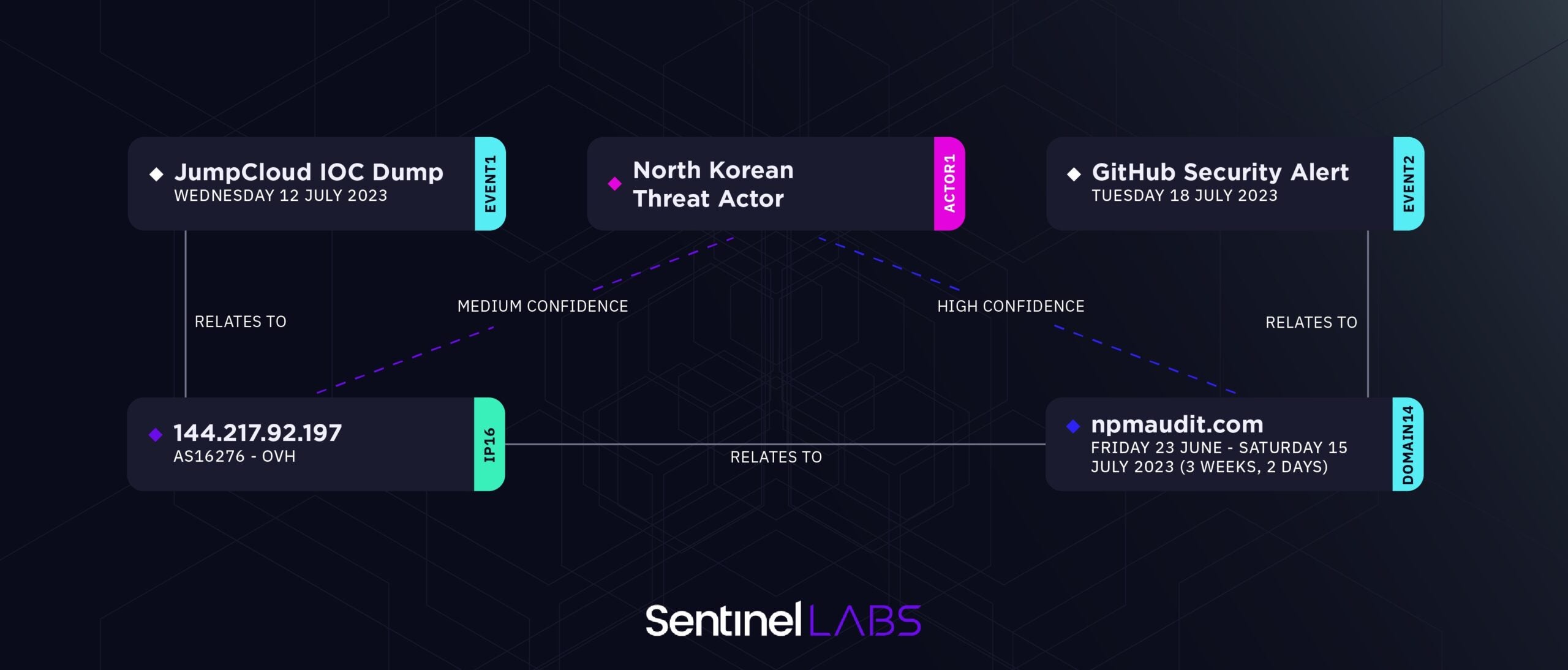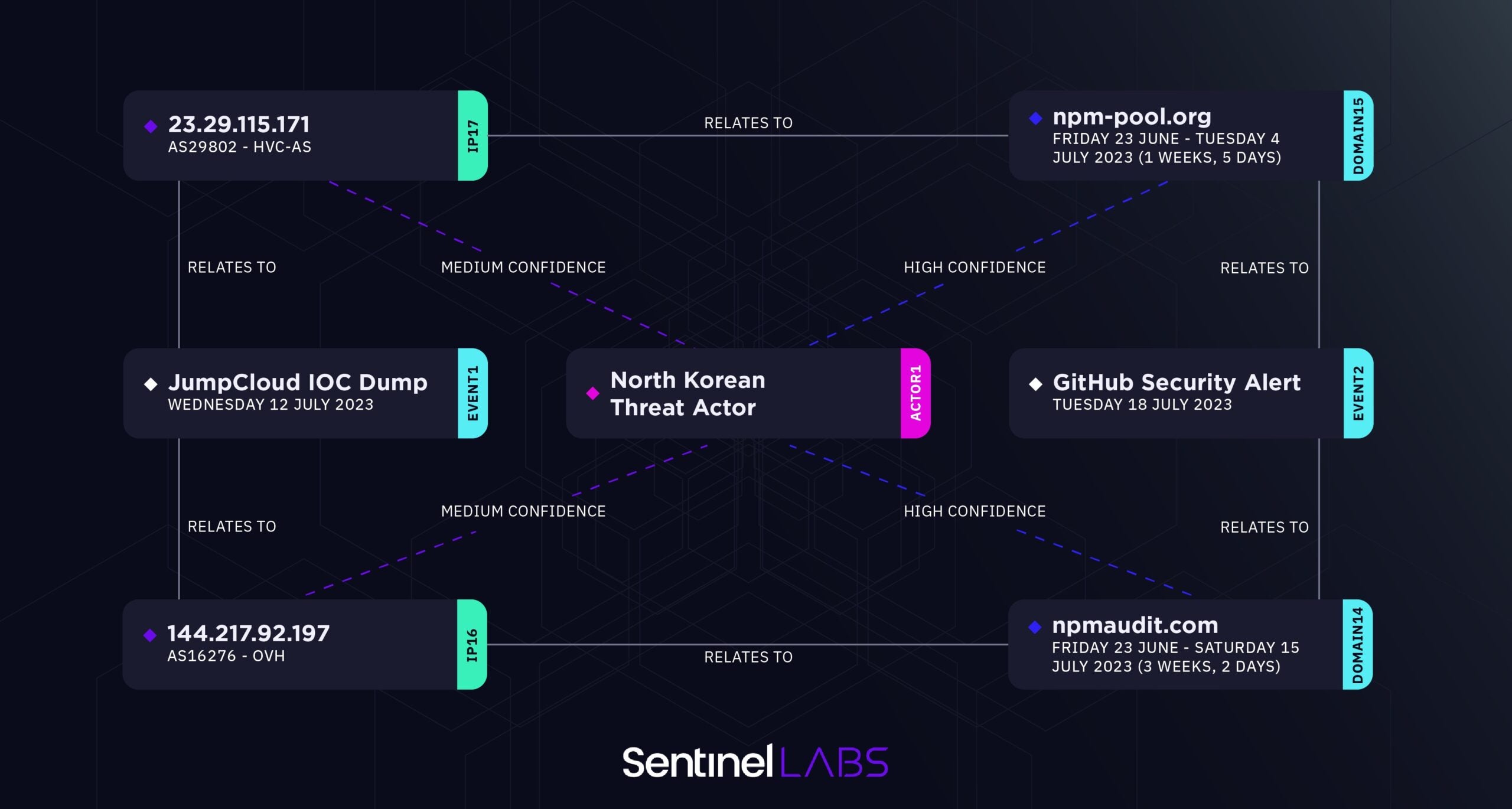
2023-7-20 18:0:14 Author: www.sentinelone.com(查看原文) 阅读量:20 收藏
In recent news, the cloud-based IT management service JumpCloud publicly shared details gathered from the investigation into an intrusion on their network. Alongside the updated details, the organization shared a list of associated indicators of compromise (IOCs), noting attribution to an unnamed “sophisticated nation-state sponsored threat actor”.
Reviewing the newly released indicators of compromise, we associate the cluster of threat activity to a North Korean state sponsored APT. The IOCs are linked to a wide variety of activity we attribute to DPRK, overall centric to the supply chain targeting approach seen in previous campaigns.
Infrastructure Analysis
Based on the IOCs shared by JumpCloud, we were able to analyze the threat actor’s infrastructure. The following list is our starting point:
Domains
| alwaysckain.com | canolagroove.com | centos-pkg.org |
| centos-repos.org | datadog-cloud.com | datadog-graph.com |
| launchruse.com | nomadpkg.com | nomadpkgs.com |
| primerosauxiliosperu.com | reggedrobin.com | toyourownbeat.com |
| zscaler-api.org |
IP Addresses
| 51.254.24.19 | 185.152.67.39 | 70.39.103.3 |
| 66.187.75.186 | 104.223.86.8 | 100.21.104.112 |
| 23.95.182.5 | 78.141.223.50 | 116.202.251.38 |
| 89.44.9.202 | 192.185.5.189 | 162.241.248.14 |
| 179.43.151.196 | 45.82.250.186 | 162.19.3.23 |
| 144.217.92.197 | 23.29.115.171 | 167.114.188.40 |
| 91.234.199.179 |
By mapping out this infrastructure, it is possible to show the links between the diverse set of IP addresses and pick up various patterns.
Triggering alerts on 192.185.5[.]189 alone is ill advised, as it’s a shared hosting server for many domains and not an indicator of malicious activity by itself. However, toyourownbeat[.]com shares an SSL certificate with skylerhaupt[.]com, indicating a potential relationship in owner.
The indicator 144.217.92[.]197 shared by JumpCloud does not host any domains listed, but we can see one similar: npmaudit[.]com, which was just recently shared by GitHub associated with an alert of their own. Based on public details available as of this writing, it’s unclear if the GitHub alert originated from the JumpCloud incident or if they are separate efforts by the same attacker.

Moving on to IP address 23.29.115[.]171, we can see through PDNS data that the domain npm-pool[.]org is related. Notably, this domain is quite similar to the NPM theme of domains shared in the GitHub alert.

While the following is not a strong indicator of attribution alone, it’s noteworthy that specific patterns in how the domains are constructed and used follow a similar pattern to other DPRK linked campaigns we track. Indicators with suspected actor association, but unverified as of this writing, include junknomad[.]com and insatageram[.]com (registered with jeanettar671belden[@]protonmail[.]com).
Additional pivots of potential interest can be made through other IPs, including 167.114.188[.]40, and to a variety of low confidence attacker-associated infrastructure.
Following the profile of the associated infrastructure from both the JumpCloud intrusion and the GitHub security alert, we can expand to further associated threat activity. For example, we can see clear links to other NPM and “package” themed infrastructure we associate with high to medium confidence, as noted in the list below. This list further expands thanks to the findings and blog from Phylum in late June.
npmjscloud[.]com npmcloudjs[.]com nodepkg[.]com dadiwarm[.]com 216.189.145[.]247 npmjsregister[.]com 142.44.178[.]222 tradingprice[.]net bi2price[.]com
Trivial pivots from here can be made to similar behaving infrastructure linked to TraderTraitor, as noted by GitHub, plus those of AppleJeus such as Celas Trade Pro via celasllc[.]com.
Conclusion
It is evident that North Korean threat actors are continuously adapting and exploring novel methods to infiltrate targeted networks. The JumpCloud intrusion serves as a clear illustration of their inclination towards supply chain targeting, which yields a multitude of potential subsequent intrusions. The DPRK demonstrates a profound understanding of the benefits derived from meticulously selecting high-value targets as a pivot point to conduct supply chain attacks into fruitful networks.
如有侵权请联系:admin#unsafe.sh